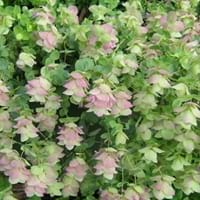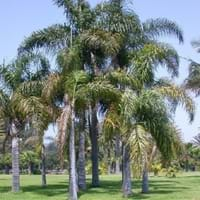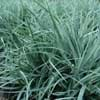Life Span
Perennial
Perennial
Origin
Hybrid origin
United States, California
Types
Kent Beauty
Amethyst Falls
Barbara Tingey
Not Available
Number of Varieties
Not Available
Habitat
Grassland, Open scrub, Rocky areas
Semi desert, Subtropical climates
USDA Hardiness Zone
5-8
7-9
Sunset Zone
Not Available
3b, 4, 5, 6, 7, 8, 9, 11, 12, 13, 14, 15, 16, 17, 18, 19, 20, 21, 22, 23, 24
Habit
Clump-Forming
Spreading
Minimum Height
Not Available
Minimum Width
Not Available
Flower Color
Pink
Red, Yellow green
Flower Color Modifier
Bicolor
Bicolor
Fruit Color
Not Available
Sienna, Chocolate
Leaf Color in Spring
Dark Green
Green
Leaf Color in Summer
Dark Green
Dark Green
Leaf Color in Fall
Dark Green
Yellow, Yellow green, Gold
Leaf Color in Winter
Light Green
Not Available
Leaf Shape
Oval
Irregular
Plant Season
Summer, Fall
Spring, Summer, Fall, Winter
Sunlight
Full Sun
Full Sun, Partial Sun
Type of Soil
Loam
Clay, Loam
The pH of Soil
Neutral, Alkaline
Acidic, Neutral, Alkaline
Soil Drainage
Well drained
Average
Bloom Time
Late Summer, Early Fall
Spring
Tolerances
Drought
Drought
Where to Plant?
Container, Ground, Pot
Ground
How to Plant?
Seedlings
Seedlings, Stem Planting
Plant Maintenance
Medium
Medium
Watering Requirements
Allow soil to be completely dry in between waterings, Does not require lot of watering, Water twice a day in the initial period, Water when soil is dry
Form a Soil ring to water efficiently, Keep ground moist, Requires watering in the growing season, Water more in summer, Water when soil is dry
In Summer
Lots of watering
Lots of watering
In Spring
Moderate
Moderate
In Winter
Average Water
Average Water
Soil pH
Neutral, Alkaline
Acidic, Neutral, Alkaline
Soil Type
Loam
Clay, Loam
Soil Drainage Capacity
Well drained
Average
Sun Exposure
Full Sun
Full Sun, Partial Sun
Pruning
Remove damaged leaves, Remove dead branches, Remove dead leaves
Don't prune in winter, No pruning needed in the early stages, Prune if you want to improve plant shape, Remove deadheads
Fertilizers
All-Purpose Liquid Fertilizer
All-Purpose Liquid Fertilizer
Pests and Diseases
Red blotch
Fungal Diseases
Plant Tolerance
Drought
Drought
Flowers
Yes
Insignificant
Flower Petal Number
Single
Not Available
Fragrant Leaf
Not Available
No
Foliage Texture
Fine
Medium
Foliage Sheen
Matte
Glossy
Attracts
Butterflies
Birds
Allergy
Not Available
no allergic reactions
Aesthetic Uses
Showy Purposes
Not Used For Aesthetic Purpose
Beauty Benefits
Not Available
Not Available
Environmental Uses
Air purification
Air purification
Medicinal Uses
Bloating, Bronchitis, Cough, Cramps, Croup, Gastrointestinal disorders, Headache, Rheumatoid arthritis, Urinary tract problems
No Medicinal Use
Part of Plant Used
Leaves
Bark, Leaves, Wood
Other Uses
Employed in herbal medicine, Used As Food
Cattle Fodder, Used by tanners in tanning leather, Used in making musical instruments, Wood is used for making furniture, Wood is used for ship building, Wood is used in construction
Used As Indoor Plant
Yes
No
Used As Outdoor Plant
Yes
Yes
Garden Design
Container, Edging, Groundcover, Mixed Border
Feature Plant, Shade Trees
Botanical Name
ORIGANUM 'Rose Dome'
QUERCUS lobata
Common Name
Ornamental Oregano
California Swamp Oak, California White Oak, Roble Oak, Valley Oak
In Hindi
सजावटी अजवायन
घाटी ओक
In German
Ornamental Oregano
Tal Eiche
In French
ornement origan
Oak Valley
In Spanish
Ornamentales orégano
valle del roble
In Greek
καλλωπιστικά Ρίγανη
Valley Oak
In Portuguese
ornamental Oregano
vale Oak
In Polish
ozdobne Oregano
Dolina Oak
In Latin
decentius Oregano
Oak vallis
Phylum
Not Available
Not Available
Class
Magnoliopsida
Not Available
Order
Not Available
Fagales
Family
Lamiaceae
Fagaceae
Clade
Angiosperms, Eudicots
Angiosperms, Eudicots, Rosids
Tribe
Mentheae
Not Available
Subfamily
Pitcairnioideae
Not Available
Number of Species
Not Available
Importance of Ornamental Oregano and Valley Oak
Want to have the most appropriate plant for your garden? You might want to know the importance of Ornamental Oregano and Valley Oak. Basically, these two plants vary in many aspects. Compare Ornamental Oregano and Valley Oak as they differ in many characteristics such as their life, care, benefits, facts, etc. Every gardener must at least have the slightest clue about the plants he wants to plant in his garden. Compare their benefits, which differ in many ways like facts and uses. The medicinal use of Ornamental Oregano is Bloating, Bronchitis, Cough, Cramps, Croup, Gastrointestinal disorders, Headache, Rheumatoid arthritis and Urinary tract problems whereas of Valley Oak is No Medicinal Use. Ornamental Oregano has beauty benefits as follows: Not Available while Valley Oak has beauty benefits as follows: Not Available.
Compare Facts of Ornamental Oregano vs Valley Oak
How to choose the best garden plant for your garden depending upon its facts? Here garden plant comparison will help you to solve this query. Compare the facts of Ornamental Oregano vs Valley Oak and know which one to choose. As garden plants have benefits and other uses, allergy is also a major drawback of plants for some people. Allergic reactions of Ornamental Oregano are Not Available whereas of Valley Oak have no allergic reactions respectively. Having a fruit bearing plant in your garden can be a plus point of your garden. Ornamental Oregano has no showy fruits and Valley Oak has showy fruits. Also Ornamental Oregano is flowering and Valley Oak is not flowering . You can compare Ornamental Oregano and Valley Oak facts and facts of other plants too.





